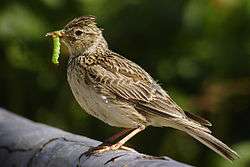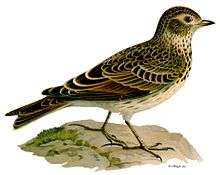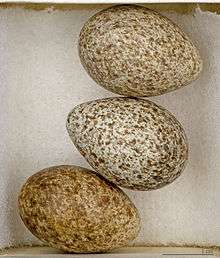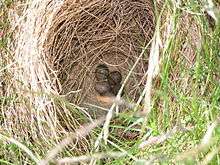Eurasian skylark
| Eurasian skylark | |
|---|---|
 | |
| With caterpillar caught in beak | |
| Song of Eurasian skylark | |
| Scientific classification | |
| Kingdom: | Animalia |
| Phylum: | Chordata |
| Class: | Aves |
| Order: | Passeriformes |
| Family: | Alaudidae |
| Genus: | Alauda |
| Species: | A. arvensis |
| Binomial name | |
| Alauda arvensis Linnaeus, 1758 | |
| Subspecies | |
|
see text | |
The Eurasian skylark (Alauda arvensis) is a small passerine bird species. It is a wide-spread species found across Europe and Asia with introduced populations in many other parts of the world. The genus name is from the Latin alauda, "lark". Pliny thought the word was originally of Celtic origin. The specific arvensis is also Latin, and means "of the field".[2]
Taxonomy and systematics
Formerly, many authorities considered the Japanese skylark as a separate species. It is now usually considered a subspecies of the Eurasian skylark.[3] Alternate names for the Eurasian skylark include common skylark, Eurasian lark, European skylark, Northern skylark and skylark.
Subspecies
Eleven subspecies are recognized:[4]
- North Eurasian skylark (A. a. arvensis) - Linnaeus, 1758: Found in northern, western and central Europe
- South-west Iberian Eurasian skylark (A. a. sierrae) - Weigold, 1913: Found in Portugal, central and southern Spain
- North-west African Eurasian skylark (A. a. harterti) - Whitaker, 1904: Found in north-western Africa
- North Mediterranean Eurasian skylark (A. a. cantarella) or Caucasian skylark - Bonaparte, 1850: Originally described as a separate species. Found in southern Europe from north-eastern Spain to Turkey and the Caucasus
- Transcaucasian Eurasian skylark (A. a. armenica) - Bogdanov, 1879: Found from south-eastern Turkey to Iran
- Steppe Eurasian skylark (A. a. dulcivox) or West Siberian skylark - Hume, 1872: Originally described as a separate species. Found from south-eastern European Russia and western Siberia to north-western China and south-western Mongolia
- A. a. kiborti - Zaliesski, 1917: Also formerly known as Japanese skylark. Found in southern Siberia, northern and eastern Mongolia and north-eastern China
- A. a. intermedia - Swinhoe, 1863: Originally described as a separate species. Found from north-central Siberia to north-eastern China and Korea
- A. a. pekinensis - Swinhoe, 1863: Originally described as a separate species. Found in north-eastern Siberia, Kamchatka Peninsula and Kuril Islands (western Russia)
- A. a. lonnbergi - Hachisuka, 1926: Found on northern Sakhalin (western Russia)
- Japanese Skylark (A. a. japonica) - Temminck & Schlegel, 1848: Originally described as a separate species. Found on southern Sakhalin, southern Kuril Islands, Japan and Ryukyu Islands
Description




The Eurasian skylark is 16 to 18 centimetres long. It is a bird of open farmland and heath, known throughout its range for the song of the male, which is delivered in hovering flight from heights of 50 to 100 m, when the singing bird may appear as just a dot in the sky from the ground. The long, unbroken song is a clear, bubbling warble delivered high in the air while the bird is rising, circling or hovering.[5] The song generally lasts two to three minutes, but it tends to last longer later in the mating season, when songs can last for 20 minutes or more. The male has broader wings than the female. This adaptation for more efficient hovering flight may have evolved because of female Eurasian skylarks' preference for males that sing and hover for longer periods and so demonstrate that they are likely to have good overall fitness.
Like most other larks, the Eurasian skylark is a rather dull-looking species on the ground, being mainly brown above and paler below. It has a short blunt crest on the head, which can be raised and lowered. In flight it shows a short tail and short broad wings. The tail and the rear edge of the wings are edged with white, which are visible when the bird is flying away, but not if it is heading towards the observer. The Eurasian skylark has sturdy legs and spends much time on the ground foraging for seeds, supplemented with insects in the breeding season.
Distribution and habitat
This lark breeds across most of Europe and Asia and in the mountains of north Africa. It is mainly resident in the west of its range, but eastern populations are more migratory, moving further south in winter. Even in the milder west of its range, many birds move to lowlands and the coast in winter. Asian birds appear as vagrants in Alaska; this bird has also been introduced in Hawaii, Canada, the continental United States, Mexico, Peru, Uruguay, Brazil, Argentina, Chile, the Falkland Islands, South Africa, Australia and New Zealand.[6]
Behaviour and ecology
Breeding
The Eurasian skylark makes a grass nest on the ground, hidden among vegetation. It is sometimes found nesting in bracken, using it for cover. Generally the nests are very difficult to find. Nesting may start in late March or early April, and three to six eggs are laid. A second or third brood may be started later in the year. The eggs are yellow/white with brownish/purple spots mainly at the large end. The Eurasian skylark is a host of the brood-parasitic Common cuckoo.
Threats

In the UK, Eurasian skylark numbers have declined over the last 30 years, as determined by the Common Bird Census started in the early 1960s by the British Trust for Ornithology. There are now only 10% of the numbers that were present 30 years ago. The RSPB have shown that this massive decline is mainly due to changes in farming practices and only partly due to pesticides. In the past cereals were planted in the spring, grown through the summer and harvested in the early autumn. Cereals are now planted in the autumn, grown through the winter and are harvested in the early summer. The winter grown fields are much too dense in summer for the Eurasian skylark to be able to walk and run between the wheat stems to find its food.
English farmers are now encouraged and paid to maintain and create biodiversity for improving the habitat for Eurasian skylarks. Natural England's Environmental Stewardship Scheme offers 5 and 10-year grants for various beneficial options. For example there is an option where the farmer can opt to grow a spring cereal instead of a winter one, and leave the stubble untreated with pesticide over the winter. The British Trust for Ornithology likens the stubbles to "giant bird tables" – providing spilt grain and weed seed to foraging birds.[7]
The RSPB's research, over a six-year period, of winter-planted wheat fields has shown that suitable nesting areas for Eurasian skylarks can be made by turning the seeding machine off (or lifting the drill) for a 5 to 10 metres stretch as the tractor goes over the ground to briefly stop the seeds being sown. This is repeated in several areas within the same field to make about two skylark plots per hectare. Subsequent spraying and fertilising can be continuous over the entire field. DEFRA suggests that Eurasian skylark plots should not be nearer than 24 m to the perimeter of the field, should not be near to telegraph poles, and should not be enclosed by trees.
When the crop grows, the Eurasian skylark plots (areas without crop seeds) become areas of low vegetation where Eurasian skylarks can easily hunt insects, and can build their well camouflaged ground nests. These areas of low vegetation are just right for skylarks, but the wheat in the rest of the field becomes too closely packed and too tall for the bird to seek food. At the RSPB's research farm in Cambridgeshire skylark numbers have increased threefold (from 10 pairs to 30 pairs) over six years. Fields where Eurasian skylarks were seen the year before (or nearby) would be obvious good sites for skylark plots. Farmers have reported that skylark plots are easy to make and the RSPB hope that this simple effective technique can be copied nationwide.
In culture
When the word "lark" is used without specification, it usually refers to this species (OED). A collective noun for Eurasian skylarks is an "exaltation". Although the OED describes this usage as "fanciful", it traces it back to a quotation from John Lydgate dating from about 1430. The verb "skylark", originally used by sailors, means "play tricks or practical jokes; indulge in horseplay, frolic". The verb and noun "lark", with similar meaning, may be related to "skylark" or to the dialect word "laik" (New Shorter OED).
The bird is the subject of poems by Percy Bysshe Shelley (To a Sky-Lark), George Meredith (The Lark Ascending), Ted Hughes (Skylarks), and numerous others; of a play by Henrik Ibsen entitled "A Doll's House" and of pieces of music including The Lark Ascending by Ralph Vaughan Williams (inspired by the eponymous poem). It is also the bird emblem of Kumamoto Prefecture.[8]
References
- ↑ BirdLife International (2012). "Alauda arvensis". IUCN Red List of Threatened Species. Version 2013.2. International Union for Conservation of Nature. Retrieved 26 November 2013.
- ↑ Jobling, James A (2010). The Helm Dictionary of Scientific Bird Names. London: Christopher Helm. pp. 37, 56. ISBN 978-1-4081-2501-4.
- ↑ "Alauda japonica - Avibase". avibase.bsc-eoc.org. Retrieved 2016-12-06.
- ↑ "IOC World Bird List 6.4". IOC World Bird List Datasets. doi:10.14344/ioc.ml.6.4.
- ↑ Young, Geoffrey (1985). The Sunday Times Countryside Companion. Country Life Books. p. 145. ISBN 0-600-35729-5.
- ↑ Long, John L. (1981). Introduced Birds of the World. Agricultural Protection Board of Western Australia. pp. 21–493
- ↑ BTO News Number 269, March to April 2007, page 15
- ↑ Kumamoto Prefecture- The East Asia Local and Regional Government Congress
Further reading
- Lidster, James (2007). Identification: Skylark and Woodlark Birdwatch
External links
| Wikimedia Commons has media related to Eurasian skylark. |
- Oiseaux images
- Eurasian skylark on BBC website – includes a photograph of a skylark plot
- A nature feature "The Lark Ascending" broadcast June 2006 on BBC radio 4 – website includes photograph of a skylark plot
- Eurasian skylark plots, the Eurasian skylark, and the RSPB's Volunteer & Farmer Alliance on RSPB website
- Eurasian skylark ecology on RSPB website
- Ageing and sexing (PDF; 1.3 MB) by Javier Blasco-Zumeta & Gerd-Michael Heinze
- UKBAP site description
- List of skylark poems
